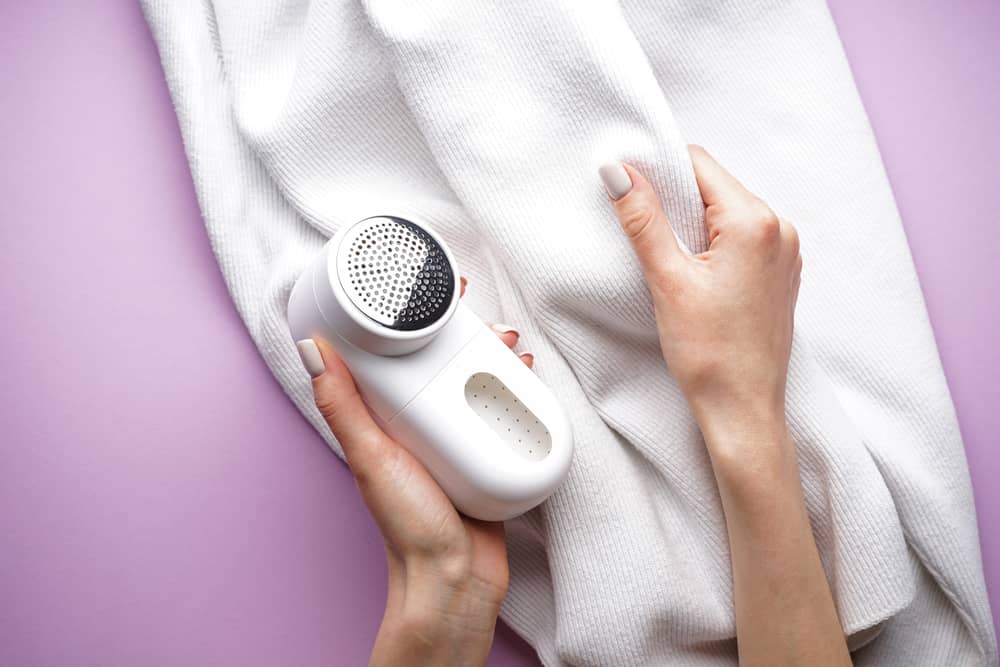Imagine you’re getting ready for an important meeting.
And just as you’re about to step out, you notice it — lint!
This tiny nuisance can be a big spoiler to your otherwise impeccable attire.
But it doesn’t have to ruin your outfit. Here’s how to keep your clothes lint free.
What is Lint, Anyway?
Lint comes from the natural and synthetic fibres that make up fabric. Common sources include cotton, wool, and polyester.
During manufacturing, these fibres are woven or knitted together to create fabric.
However, not all fibres are bound tightly, leaving some loose ends.
Lint can also be due to the friction between fabrics during wear and washing.
Fibres loosen and form small balls or “lint.”
Essential Tools for Lint Removal
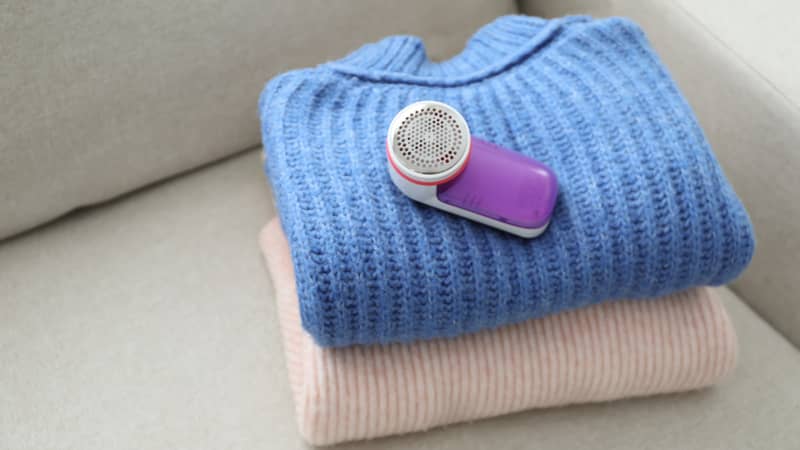
Here are some must-haves for effective lint removal.
- Lint roller: Ideal for quick touch-ups and smaller items.
- Fabric shaver (or a disposable shaver): Perfect for removing pilling from sweaters and upholstery.
- Sticky tape: A quick alternative when you don’t have a lint roller.
- Dryer sheets: Reduce static cling and lint in the laundry.
- Vacuum with upholstery attachment: For larger items like furniture.
Now that we’ve explored what lint is and how it can affect our clothing, let’s move on to the practical side.
How to Remove Lint from Clothes
Here’s a cheat sheet for removing lint from clothes.
1. Spot the lint buildup
Begin by thoroughly inspecting your garment under good lighting to spot lint buildup.
Turn the garment inside out to check hidden areas, especially around seams, pockets, and other nooks where lint tends to accumulate.
Focus on areas prone to lint, such as collars, cuffs and underarms, which are more susceptible to friction and movement.
This step will help you choose the right lint removal tool.
2. Prepare your clothes
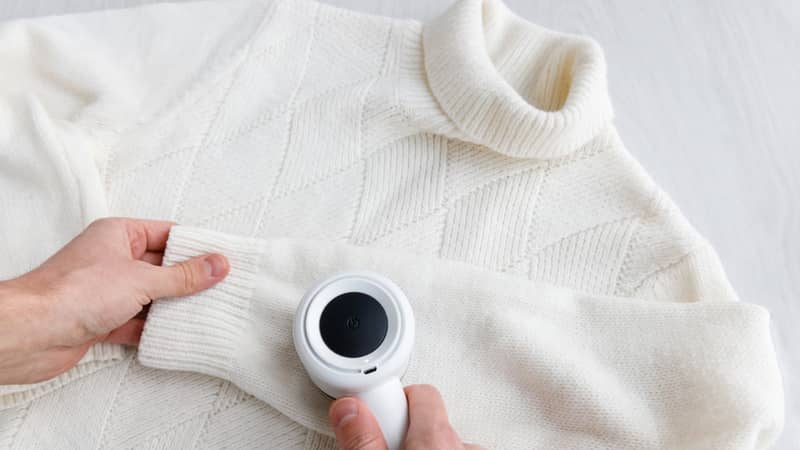
Once you’ve identified where the lint is, prepare your clothing for the lint removal process.
Lay the garment flat on a clean, smooth surface like a table or an ironing board.
This will give you a stable base to work on.
Make sure the fabric is smooth and wrinkle-free to ensure you don’t miss any lint.
If the garment has buttons or zippers, secure them to keep the fabric taut and in place while you work.
3. Use gentle strokes to remove lint
Choosing the right tool for your fabric type and the amount of lint is crucial.
Whether you’re using tape and lint rollers, a lint brush or a fabric shaver, use gentle, consistent strokes.
When using rollers and brushes, move downwards along the fabric, while fabric shavers are best used in gentle circular motions.
Be particularly careful with delicate fabrics like silk or fine knits to avoid damaging them.
4. Final check and touch-up
After you’ve gone over the entire garment, do a final inspection to check for any missed lint spots.
Pay extra attention to stubborn areas and go over them again if necessary.
Changing your viewing angle can sometimes reveal lint that was missed during the first pass.
So, inspecting the garment from different perspectives is a good idea.
5. Clean and store tools
When you’re finished, clean your tools!
For lint rollers, remove the used adhesive layer.
For brushes and fabric shavers, clean out the collected lint.
Finally, store your lint removal tools in a dry, accessible place.
How to Remove Lint in Your Washer and Dryer
Removing lint from your washer and dryer is an essential maintenance task that keeps your clothes lint-free and ensures the longevity and efficiency of your appliances.
Removing lint from a dryer
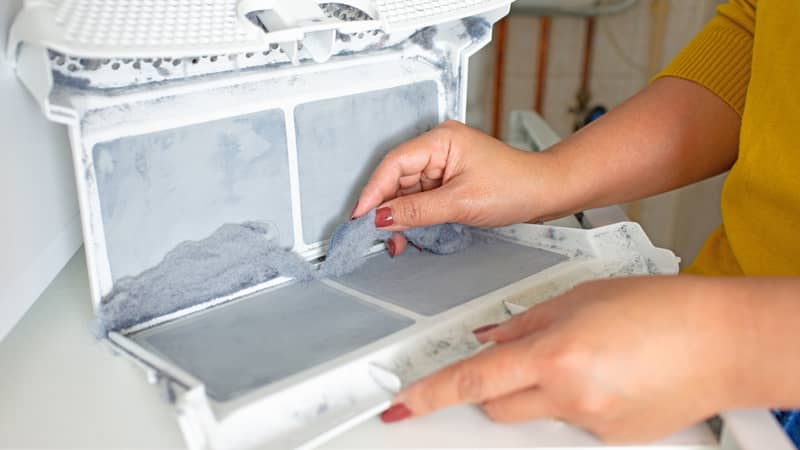
Start by regularly cleaning your dryer’s lint trap, typically found inside the dryer door or on top of the machine.
After each use, remove the trap and gently peel away the layer of lint.
Occasionally using a vacuum cleaner to remove accumulated lint around the trap area or the vent hose is also a good idea.
This not only prevents potential fire hazards but also helps in maintaining the dryer’s efficiency.
It’s also beneficial to periodically check and clean the dryer’s vent hose and exterior vent.
Detach the hose from the back of the dryer and the wall, and use a long-handled vent brush to remove any lint buildup inside the hose and the vent.
This is crucial as lint accumulation can reduce airflow and fire hazards in these areas.
Removing lint from a washer
In the case of your washing machine, lint can accumulate in various parts of the machine.
Many washers have a lint filter that should be cleaned regularly following the manufacturer’s instructions.
If your machine doesn’t have a lint filter, running an empty hot water cycle with a cup of white vinegar can help dissolve any residual lint and detergent build-up.
Additionally, wiping around and under the rubber gaskets and seals can help remove trapped lint and debris.
Top Tips to Prevent Lint Buildup
Let’s take a minute to think about how to prevent lint from even accumulating on our clothes and appliances.
Boost your laundry routine

Start by selecting gentle wash cycles and using the right amount of laundry detergent.
This approach is less abrasive on your clothes, reducing fibre breakdown and lint production.
It’s also important not to overload the washing machine.
Overloading increases friction between clothes, leading to more lint.
Regularly cleaning your washing machine, including lint traps or filters, is essential to prevent lint from previous loads from clinging to your clothes.
Sort laundry to prevent lint
Sorting laundry is a crucial step in preventing lint accumulation on your clothes.
This process involves more than just separating colours; it’s about understanding and categorising fabrics based on their lint-producing or attracting properties.
Divide your laundry into a group of lint-producing items, such as towels, fleece and heavy cotton.
Then, prep another pile of lint-attracting items, like synthetic fabrics and finely woven materials. You can dedicate a washing basket for each type of item.
Washing these groups separately will significantly reduce the transfer of lint between garments.
Another proven method to prevent lint is to use mesh laundry bags for delicate items or those particularly prone to attracting lint.
The bags reduce the direct friction between clothes, thus limiting lint transfer.
Despite careful sorting, some lint may still appear on clothes post-wash.
In such cases, having a quality lint roller or brush handy to remove any remaining lint can be very effective.
Lint considerations for black clothing
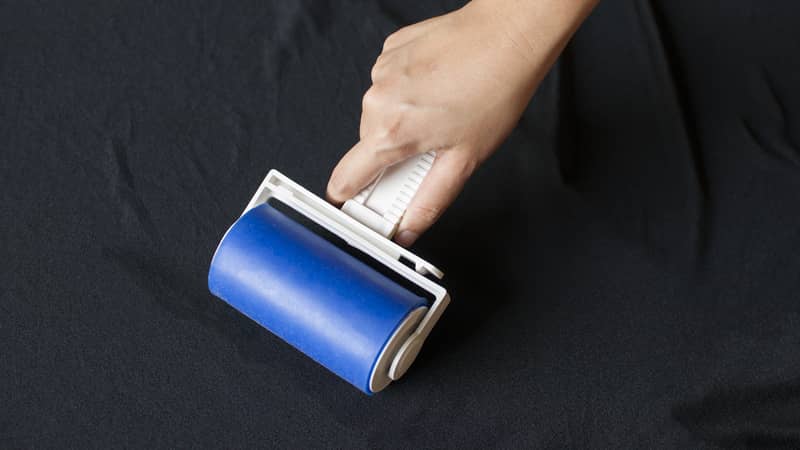
Black clothing requires special attention when it comes to lint because lint is more visible on dark fabrics.
It’s best to wash your black clothes separately from lighter, fluffier fabrics that are more likely to shed lint.
Washing black clothes with similar dark-coloured items reduces the risk of lint transfer.
Our cleaning experts also recommend using liquid detergent to wash black clothes.
This is because powder detergents can sometimes leave a white residue that clings to the fabric, attracting lint.
FAQ
How do I remove stubborn lint without damaging my clothes?
You can avoid damaging clothes by using a high-quality fabric shaver or a lint brush.
For delicate fabrics, consulting a cleaning professional might be the safest approach.
Why won’t lint come out of my clothes?
Sometimes, lint gets embedded in the fabric, especially in textures like fleece.
Regularly using a fabric shaver or lint roller can help prevent this buildup.
Can fabric softener remove lint from clothes?
Not really.
TL;DR — fabric softeners can reduce static cling and indirectly help minimise lint on clothes.
The longer story is that fabric softener coats the fibres of the fabric.
This coating helps reduce the friction between fibres during the washing and drying process.
Less friction means less pilling and fibre breakage, which can lead to less lint formation on your clothes.
Can dryer sheets remove lint?
Nope! Like fabric softeners, dryer sheets are more about preventing lint than removing it.
They are designed to work in the dryer to soften fabrics, reduce static cling and impart a pleasant fragrance.

